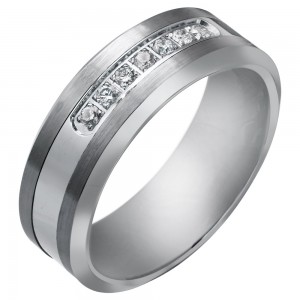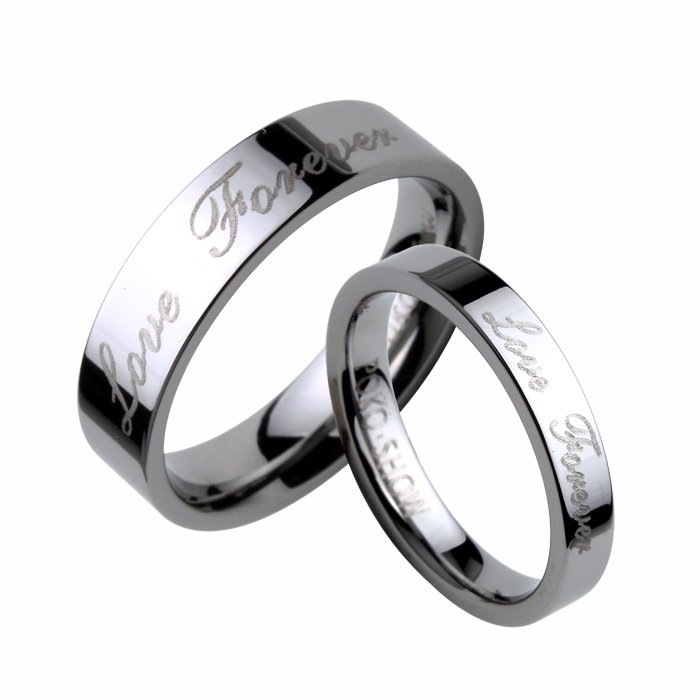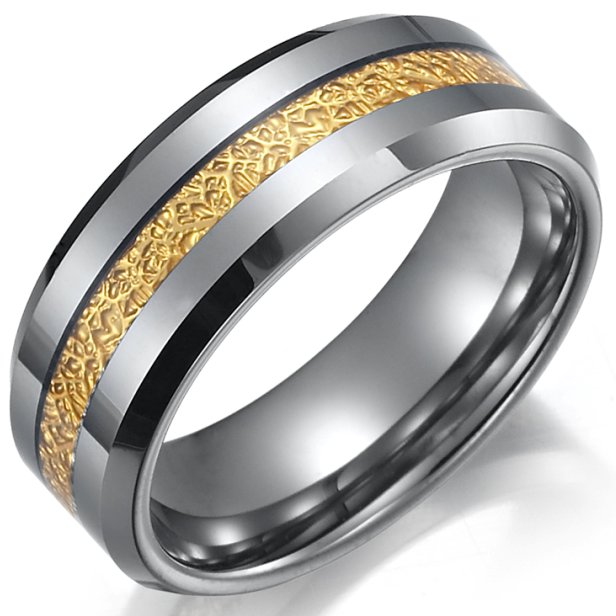How to Identify Tungsten Gold Jewelry
- Details
- Category: Tungsten Information
- Published on Monday, 04 February 2013 19:02
- Hits: 2730
"Diamond is forever and one will forever" Once the number of people crazy at it. Today, this frenzy toward another rising star swept away by the wave of a wave after wave, and a greater come from behind to replace the diamond king of the gas. Its name is called - "tungsten". Why choose tungsten jewelry
 Tungsten gold jewelry has never worn, never fade, never deformation characteristics, with a diamond-like luster, and the price is much lower than the diamond, great Potential appreciation. Tungsten jewelry is jewelry, Europe and the United States is now the most popular young people's favorite, the traditional gold and silver jewelry hard to attract the youth of the pursuit of personalized fashion.
Tungsten gold jewelry has never worn, never fade, never deformation characteristics, with a diamond-like luster, and the price is much lower than the diamond, great Potential appreciation. Tungsten jewelry is jewelry, Europe and the United States is now the most popular young people's favorite, the traditional gold and silver jewelry hard to attract the youth of the pursuit of personalized fashion.
Tungsten gold jewelry because of its special attributes to become the first choice of gifts.
Tungsten identification: an endless stream of tungsten Rado outstanding performance has been more and more people accepted, respected, and the jewelry industry is also widely used material to make jewelry, followed by shoddy phenomenon. The following teaches you how to quickly identify genuine and fake tungsten gold:
One with a Knife: true tungsten never has the slightest scratch, leave there will be scratches; (can be hard to scratch, but do not use diamond knife!)
Look shiny: true tungsten after high polished to a mirror, and leave the side reaches the mirror effect and trachoma;
Weight of: tungsten four times larger than the density of stainless steel, with the density of gold is almost the same, so the texture is good, a lot of weight in your hand;
4 shop around: the so-called are not afraid do not know what's what, afraid of confinement, to counter than the goods is the best choice;
Men love tungsten: tungsten heavy metals, the density close to the gold, and hardness close to diamond, so shiny, the texture of other materials can not be compared, like heavy metal texture, you must not miss;
The couple selected a tungsten ring: Since ancient times, diamonds have been humans as power, dignity, status, and a symbol of wealth. Indestructible, invincible constancy and perseverance eternal masculine quality is always our goal of mankind. A diamond is forever, a bankruptcy, and tungsten, indestructible, invincible constancy and perseverance eternal masculine quality and very cheap, tungsten jewelry is engraved love on the choice of showing love.
Tungsten Jewellery Manufacturer & Supplier: Chinatungsten Online - http://www.tungsten-jewellery.com
Tel.: 86 592 5129696; Fax: 86 592 5129797
Email: sales@chinatungsten.com
Tungsten News & Tungsten Prices, 3G Version: http://3g.chinatungsten.com
Tungsten News & Tungsten Prices, WML Version: http://m.chinatungsten.com
Tungsten Jewelry Finds Its Field in the Jewelry Market
- Details
- Category: Tungsten Information
- Published on Monday, 04 February 2013 18:39
- Hits: 2686
Gold, silver and platinum have been the mainstay of the jewelry industry for many years. In these years, that dominance is about to be challenged with the rising materials like titanium and tungsten. If you still thought that tungsten was meant only for the manufacture of the filament of an electric bulb, then you are out of date. Fine tungsten jewelry can instantly make you alter your notion!
As a matter fact, the use of the tungsten is not novel in other fields. However, tungsten jewelry is quite new and soon becomes favorites for those who are big on fashion jewelry. Why it has receive fast growth and captured due reputation in the crowded jewelry marketplace? This question will invariably come to your mind.
There definitely are reasons explaining its fast growth in the jewelry market.
First, it goes to its colors. Its natural grey color and stunning luster instantly win people's love. Unlike the gold or silver or other gemstones, tungsten's grey color is low key which can offer people peace and comfort in the busy daily life. Of course, if you are not a fan to grey color, some manufacturers also offer tungsten jewelry coating with other colors like white.
Second, it is due to durability. Tungsten enjoys high hardness and is resistant to corrosion. Scratches can not be found on the jewelry. So you don't need to polish the jewelry like gold or silver jewelry. This feature makes it compatible with rough lifestyle of working people.
Third, its various designs and styles make it popular. Take tungsten rings as an example, it comes in a width of 4 mm to 6 mm. However, some companies may offer thin, feminine tungsten rings of width as small as 2mm. It also can match with other materials such as gold and many kinds of gemstones.
Fourth, uniqueness has made great contribution. Nowadays, people like to something to stand out themselves. Traditional jewelry like gold is worn by every people. Tungsten is different and is unique. As a newly discovered continent, it soon attracts persons who seek for personality and uniqueness.
Fifth, it is easy to take care of and clean. Store it in a separate jewelry box for it may scratch other jewelry because of its high hardness. If the jewelry is found to be dirty, use a special jewelry cleaning cloth to rub it and you can directly wash them in warm water if you are in a hurry.
Now you know the characteristics of the tungsten jewelry. So it's hardly surprising that more people are discovering its beauty every day and are in love with this kind of jewelry.
Tungsten Jewellery Manufacturer & Supplier: Chinatungsten Online - http://www.tungsten-jewellery.com
Tel.: 86 592 5129696; Fax: 86 592 5129797
Email: sales@chinatungsten.com
Tungsten News & Tungsten Prices, 3G Version: http://3g.chinatungsten.com
Tungsten News & Tungsten Prices, WML Version: http://m.chinatungsten.com
Why Men Love Tungsten Rings More than Ladies
- Details
- Category: Tungsten Information
- Published on Monday, 04 February 2013 18:03
- Hits: 2900
There are plenty of things to assume about whereas answering the question that why tungsten rings are men's favorites than women. Tungsten is a tough and durable metal and anything like these would surely steal men's heart. Men are invariably in rummage around for power, rigidity and strength and each one these 3 are well imparted by Tungsten rings of exclusive varieties.
 Men typically don't like to go for an assortment in jewelry and they continuously have the inclination to wear something simple.
Men typically don't like to go for an assortment in jewelry and they continuously have the inclination to wear something simple.
Why tungsten rings are men's favorites than women? It might be as a result of the color of the rings. Tungsten rings are principally on the market in gray and black shades. The look is indeed sharp. Therefore, particularly as a result of these 2 reasons most men are inclined to go for a tungsten variety. The colors grey and black have got a lot to attempt to with power and masculinity.
Affordability matters a heap when talking concerning rings. Not several can continuously choose gold, silver and platinum varieties. Men customarily search for things which are less expensive and superior in affordability and style. They do not need to pay those further pence solely for an ornament. Therefore investing for a tungsten ring seems more feasible to them. Great look in affordable pricing - therefore they need nothing more to regret.
The stylization of the tungsten rings additionally appeal a heap to men. The method they're built - the form specially encompasses a heap to say and a heap to imply. Straightforward rings with carvings and inlays and this simplicity appeals to the lads the most.
Another reason why tungsten rings are men's favorites than women is that the selection of sizes that's available. Men would like rings that don't appear to be less than seven mm in width and they ought to be such to fit the finger at best without a pinch and while not a feel of slightest discomfort. So with therefore several positives why won't men go for tungsten rings.
They're very trendy and therefore they are reining the market by way with exquisite look and style. Most men hate to travel for things that are typical both in look and appeal. Thus their choice sticks to rings created of tungsten because the metal getting used is thus terribly unique and unusual. Thus if you make an outline of the several reasons for men going for tungsten rings you have to assume about these points.
• Sturdiness of the metal
• Power and rigidity of the metal
• The inexpensive quality of the rings
• The style of the ornament
• The fashionable charm of the jewelry
Therefore when reasons are at masses why would men not opt for having that exotic ring on their finger.
Tungsten Jewellery Manufacturer & Supplier: Chinatungsten Online - http://www.tungsten-jewellery.com
Tel.: 86 592 5129696; Fax: 86 592 5129797
Email: sales@chinatungsten.com
Tungsten News & Tungsten Prices, 3G Version: http://3g.chinatungsten.com
Tungsten News & Tungsten Prices, WML Version: http://m.chinatungsten.com
Tungsten Rings Symbolize the Term "forever"
- Details
- Category: Tungsten Information
- Published on Monday, 04 February 2013 18:24
- Hits: 2733
Tungsten ring is one of the hardest materials available, the most scratch resistant of any metal. Tungsten rings are made from tungsten metal and Carbide powder which are forged together making the most desirable polished ring on the market. On its own, tungsten is a very hard and dense metal, with the highest melting point of all metals - 6,100 degrees Fahrenheit. Alone, tungsten is vulnerable to scratches and damage just like any other metals. It gains its extreme hardness by being combined with a carbon alloy, transforming it into tungsten carbide.
 It is four times harder than titanium, twice as hard as steel and almost impossible to scratch. The resulting metal can be designed into tungsten carbide wedding band rings that are both visually stunning to please the eye, durable enough to withstand everyday use and hypo-allergenic. These rings will never loose their polish. These rings can only be damaged through extreme measures, such as abrasion from diamonds or being struck with a hammer.
It is four times harder than titanium, twice as hard as steel and almost impossible to scratch. The resulting metal can be designed into tungsten carbide wedding band rings that are both visually stunning to please the eye, durable enough to withstand everyday use and hypo-allergenic. These rings will never loose their polish. These rings can only be damaged through extreme measures, such as abrasion from diamonds or being struck with a hammer.
Tungsten jewelry wholesale is willing to offer you tungsten rings that symbolize the term "forever", especially "never worn". Men and Women's tungsten rings are durable enough for casual wear, yet brilliant enough to be a representation of lifetime commitment. Ranging from solid style tungsten carbide rings, to rings with precious metal inlays,5mm, 6mm ,7mm or 8mm, men's & women's, you will find the tungsten rings or tungsten wedding rings that perfectly represent you for a wedding, engagement, and complete your casual look in style.
Tungsten Jewellery Manufacturer & Supplier: Chinatungsten Online - http://www.tungsten-jewellery.com
Tel.: 86 592 5129696; Fax: 86 592 5129797
Email: sales@chinatungsten.com
Tungsten News & Tungsten Prices, 3G Version: http://3g.chinatungsten.com
Tungsten News & Tungsten Prices, WML Version: http://m.chinatungsten.com
Men's Tungsten Wedding Rings - a Trend to Watch for in 2013
- Details
- Category: Tungsten Information
- Published on Monday, 04 February 2013 17:44
- Hits: 2542
As we approach the holiday season, you may be thinking of "popping the question" to that special woman in your life. You are not alone. According to a survey by ABC News, November and December account for 26 percent of all marriage proposals, a fact that was first discovered by a survey of Modern Bride. Whether you choose to get down on one knee in early November or wait until the night of New Year's Eve, this means that the wedding jewelry will be a part of their  future. Men still can look at the precious metals for his bride-to-be, but a surprising new trend has developed with its choice of wedding bands for men. Men's tungsten wedding rings are quickly growing in popularity for boys, and are expected to continue to capture market share in 2013. Not only are these tough "industrial strength" sounds more affordable than gold, but also have a different look that is very attractive to men.
future. Men still can look at the precious metals for his bride-to-be, but a surprising new trend has developed with its choice of wedding bands for men. Men's tungsten wedding rings are quickly growing in popularity for boys, and are expected to continue to capture market share in 2013. Not only are these tough "industrial strength" sounds more affordable than gold, but also have a different look that is very attractive to men.
Why am I telling you all this when you are still months away from the actual wedding date? When you visit a jewelry store to buy an engagement ring, it is easy to "sell" the idea of buying the bands matching wedding later. As a result, many men end up buying the same band of yellow gold wedding that everyone has. With gold prices as high as they are, this can be a very costly endeavor. If you ask your jeweler about buying men's rings tungsten wedding, they may try to discourage that most stores only sell precious metals. Men who intend to engage in this season should be aware of the differences between the traditional gold band wedding rings and men's tungsten wedding. When it comes to fashion, it is rare that men depart from tradition in favor of something new, but tungsten is emerging as a strong contender for first place in the wedding jewelry for men. What makes the men's tungsten wedding ring so appealing?
• They are much stronger and more resistant.
• Tungsten carbide rings + shell + ceramic to scratches than other traditional and alternative metals;
• Tungsten carbide is a dense metal that is heavier than gold and is practically indestructible;
• The women men's rings tungsten wedding are a slightly darker color than white gold, and maintain its original polish indefinitely without re-seeding;
• Tungsten is a metal hypoallergenic which requires very little maintenance;
• The men's rings tungsten are also available in black and can be plated in gold;
Tungsten can be enameled, carved, polished, inlaid with carbon fiber, grooved, etched or beveled. Some of the fashion rings available today are made of tungsten, so any man can find a ring that fits your personality. So even if you need to go the traditional route with the engagement ring, her wedding ring is an expression of your individuality with men's rings tungsten wedding.
Tungsten Jewellery Manufacturer & Supplier: Chinatungsten Online - http://www.tungsten-jewellery.com
Tel.: 86 592 5129696; Fax: 86 592 5129797
Email: sales@chinatungsten.com
Tungsten News & Tungsten Prices, 3G Version: http://3g.chinatungsten.com
Tungsten News & Tungsten Prices, WML Version: http://m.chinatungsten.com





 sales@chinatungsten.com
sales@chinatungsten.com